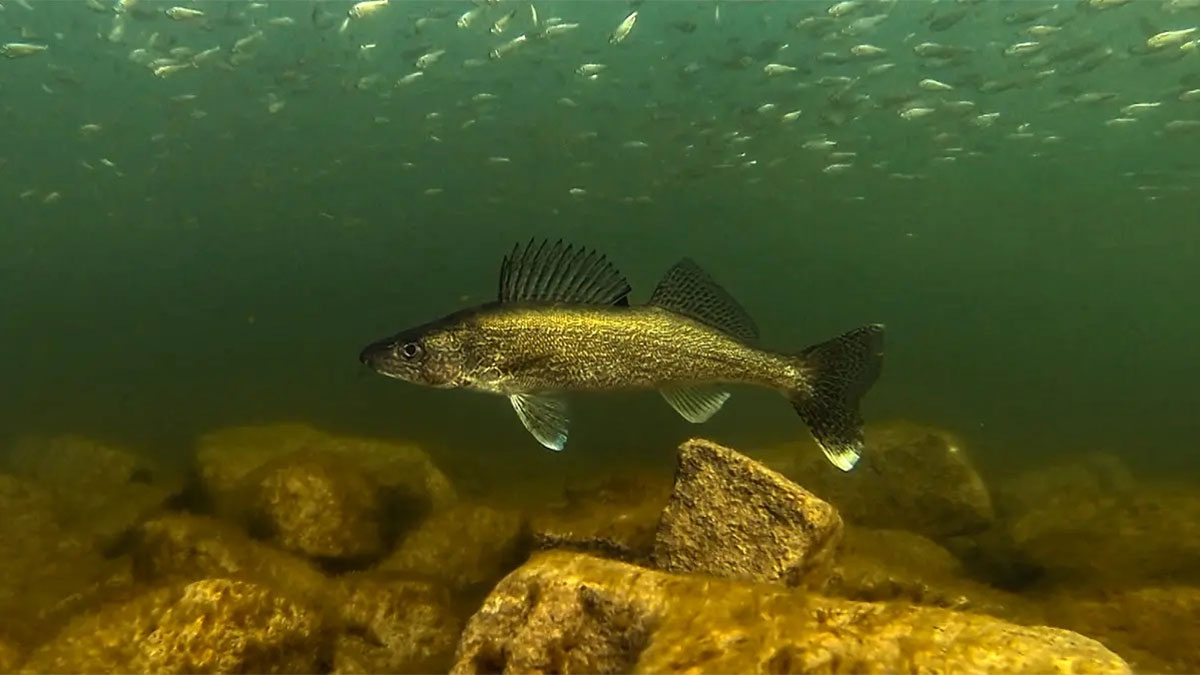The walleye, a fish shrouded in mystery with its emerald green body and mesmerizing glassy eyes, ignites a passion in anglers across North America. Renowned for their subtle bites, exceptional eyesight, and delicate flavors, these underwater phantoms present a captivating challenge. This comprehensive guide delves into the world of walleye fishing, empowering you with the knowledge and techniques to become a walleye whisperer.
Decoding the Walleye: An In-Depth Look at Behavior
Understanding walleye behavior is the cornerstone of successful fishing. Here’s a breakdown of key factors to consider:
- Habitat Preferences:
- Lacustrine Loiterers: Walleye are primarily freshwater fish, inhabiting both lakes and rivers. In lakes, they favor areas with structure like rocky points, humps, and submerged vegetation edges. These areas provide ambush points and access to prey.
- Fluvial Foragers: In rivers, walleye tend to congregate in deeper pools with current breaks, near bends where food gathers, and around structures like dams and bridges that create turbulence and attract baitfish.
- Depth and Cover Kings: Light-sensitive by nature, walleye seek refuge in deeper waters during the day, especially in summer months. At dawn, dusk, and throughout the night, they venture into shallower areas to feed, often hugging the bottom near rocks, weed beds, or sunken timber.

- Feeding Habits:
- Nocturnal Hunters: Walleye are most active feeders during low-light conditions – early morning, dusk, and nighttime. Their superior vision in low light gives them an edge over prey during these periods.
- Piscivorous Prowess: Their primary diet consists of smaller fish such as perch, minnows, and shad. However, they are opportunistic feeders and will also consume insects, leeches, and crustaceans.
Equipping Yourself for the Pursuit: The Right Tools for Walleye Success
Choosing the right equipment is paramount for a successful and enjoyable walleye fishing adventure:
- Rods:
- Power: A medium-light to medium power rod with a fast action is ideal. This combination provides the sensitivity to detect subtle walleye bites and the backbone to set the hook effectively, especially when using finesse presentations.
- Length: A 6.5-foot to 7.5-foot rod offers a good balance of casting distance, maneuverability, and fighting power, allowing you to precisely place lures and battle walleye effectively.
- Reels:
- Spinning Reels: Spinning reels are the preferred choice for walleye fishing due to their ease of use, versatility, and ability to handle various presentations. Choose a reel with a smooth drag system and sufficient line capacity to handle runs from feisty walleye.
- Lines:
- Braided Line (Main Line): Braided line in the 10-15 lb test range is a popular choice due to its superior strength, sensitivity, and minimal stretch. This allows for better bite detection and effective hooksets.
- Fluorocarbon Leader (Optional): A 2-4 foot fluorocarbon leader (8-12 lb test) adds abrasion resistance and near invisibility in clear water, giving you an edge over wary walleye.
- Lures and Baits:
- Jigs: Jigs are a highly effective and versatile option for walleye fishing. Choose from hair jigs, plastic grubs with paddle tails, or minnow imitations tipped with live bait like minnows or leeches for added enticement.
- Crankbaits: Deep-diving crankbaits that mimic baitfish are excellent for covering large areas of water and efficiently searching for active walleye.
- Live Bait Rigs: Live bait rigs using minnows, nightcrawlers, or leeches are a traditional and highly effective method, especially in pressured waters. Utilize a slip-sinker rig to allow the bait to swim naturally with the current.
- Spinner Rigs: Spinner rigs, particularly those with worm harnesses, can be trolled or drifted effectively to attract walleye with their flash and vibration.
Mastering the Art of Presentation: Effective Techniques to Catch the Elusive Walleye
Presentation is key to enticing strikes from these cautious predators. Here are some effective techniques to consider:
- Fishing Locations:
- Points and Drop-offs: Focus on areas where walleye transition between deep and shallow water, such as points and drop-offs. These areas concentrate baitfish and provide ideal feeding grounds.
- Weed Edges and Rock Piles: Target the edges of weed beds and around rock piles where walleye ambush prey. These areas offer both food sources (insects, baitfish) and ambush points for walleye. Drag jigs or crankbaits along the weed edges, or drift live bait rigs near rock piles.
- Current Breaks in Rivers: In rivers, target areas with current breaks where walleye can conserve energy while waiting to ambush prey drifting downstream. Jigs or live bait rigs presented near the bottom are effective options in these areas.

- Bait Presentation Techniques:
- Vertical Jigging: An excellent technique for deeper water or fishing directly over structure. Use short, sharp lifts of the rod tip to impart an erratic, darting action to the jig, mimicking a struggling baitfish.
- Slip Bobber Fishing: Ideal for presenting live bait at a specific depth, especially in open water or around scattered weeds. Adjust the bobber stop to keep the bait just above the bottom or hovering near suspended baitfish.
- Trolling: Use crankbaits or spinner rigs to efficiently cover large areas of water and locate schools of walleye. Vary your trolling speed to find the presentation that resonates with the fish on that particular day. Experiment with different crankbait diving depths to target walleye at various water levels.
- Casting and Retrieving: Cast jigs, crankbaits, or soft plastics along weed edges, rock piles, or other structural elements. Utilize a slow and steady retrieve with occasional pauses and twitches to imitate the natural movements of prey.
- Adapting to Conditions:
- Light Conditions: Focus your fishing efforts during low-light conditions like early morning, dusk, or overcast days when walleye are more active feeders.
- Water Temperature: Walleye prefer cooler water temperatures, typically between 55-70°F. During summer’s peak heat, they may move to deeper, cooler areas of lakes or seek shade in rivers. Adjust your fishing locations accordingly.
- Seasonal Movements: In spring, walleye move to shallow waters for spawning. In summer, they inhabit deeper structures. In fall, they return to shallower areas to feed before winter. Understanding these seasonal movements can help you target walleye more effectively throughout the year.
Additional Tips for Walleye Fishing Mastery
- Embrace Electronics: Utilize fish finders and GPS units to locate structure, schools of baitfish, and potential walleye holding areas. Mark productive spots on your GPS for future reference.
- Experiment with Colors: Walleye can be particular about lure and jig colors. Carry a variety of options, including natural patterns like perch or minnow imitations, along with brighter or darker colors to see what entices them on that day.
- Pay Attention to Details: Small details like extremely sharp hooks, proper bait presentation, and realistic lure action can significantly impact your success. Stay observant and adjust your approach based on what you see and experience on the water.
- Patience and Persistence: Walleye fishing requires patience and persistence. Don’t get discouraged if you don’t catch fish immediately. Keep trying different techniques and locations, and eventually, your efforts will be rewarded.

Robert Smith is the proud owner of Bait Barrels and Bows, a premier fishing sports store established in 1989. With over three decades of experience in the industry, Robert has honed his skills to become an expert angler, sharing his vast knowledge and passion for fishing with enthusiasts around the world. Through his store and writings, Robert provides invaluable tips and guidance, helping both novice and seasoned anglers improve their techniques and enjoy the sport to its fullest. His commitment to the fishing community is evident in his dedication to quality products and excellent customer service.

